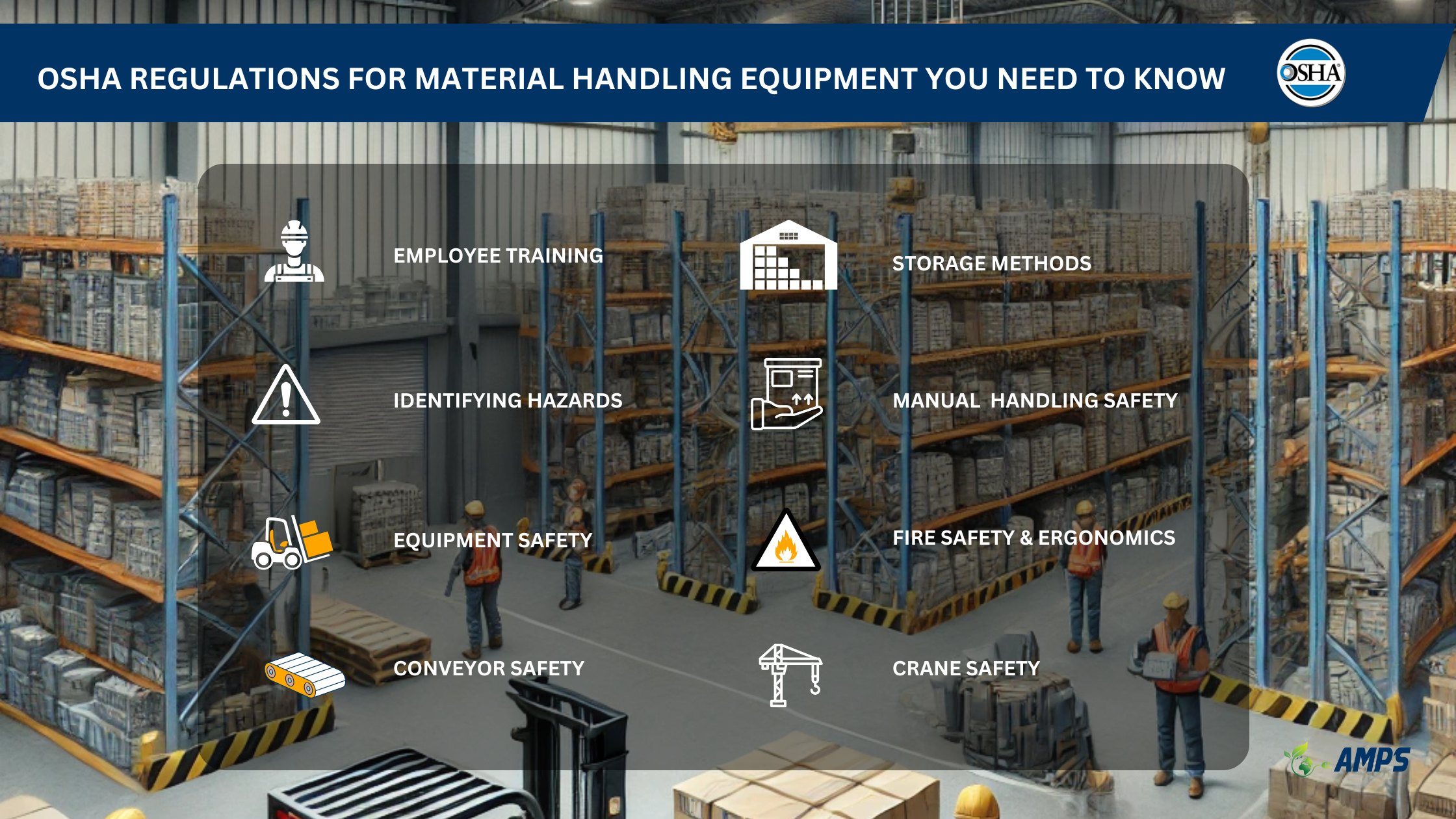OSHA Regulations for Material Handling Equipment You Need to Know

OSHA Regulations for Material Handling Equipment You Need to Know
Handling and storing material involve various processes such as lifting heavy equipment; operating a loaded truck; stacking palletized material. Efficient Material Handling is necessary for smooth operations within any industry. However, improper training and inefficient handling of material can lead to injuries. To mitigate risks OSHA (Occupational Safety and Health Administration) has established guidelines to help businesses ensure worker safety.
This blog will highlight key OSHA material handling guidelines and best practices to keep your workplace secure and efficient.
- Employee Training and Awareness
Before handling or storing materials, employees should be well versed in various safety principles such as proper work practices, equipment and controls, along with the potential hazards that come along with the task at hand. Regular safety drills and refresher courses can significantly reduce workplace accidents.
- Identifying Potential Hazards
Employees should be aware of the following potential hazards that can occur while handling and moving materials:
- Strains and sprains from lifting heavy loads improperly.
- Injuries from falling objects that have been improperly stored.
- Getting caught in pinch points while using equipment.
By understanding these risks, workers can take proactive measures to prevent injuries.
- Safety Precautions for Manual Material Handling
Manual handling is one of the most common causes of workplace injuries. To prevent accidents, OSHA recommends that workers should seek help when the load is too heavy and they cannot manage it, cannot see around or over the load, or when the task at hand seems too dangerous. OSHA also recommends these safety guidelines:
- Use proper lifting techniques (lifting with the legs, not the back).
- Wear personal protective equipment like gloves and steel-toed shoes.
- Use assistive tools such as dollies or hoists for heavy loads.
- Seek assistance when handling oversized or overly heavy materials.
- Mechanical Handling and Equipment Safety
The utilization of mechanical equipment like forklifts, cranes, and conveyors can increase the potential of new risks if proper guidelines are not followed. While handling material mechanically employees must:
- Ensure equipment operators are trained and certified.
- Display and adhere to load capacity ratings on all machinery.
- Center the load on the forks as close to the mast as possible
- Avoid overloading forklifts or cranes, as this can lead to tipping accidents.
- Regularly inspect and maintain equipment to prevent malfunctions.
- Proper Storage and Stacking Methods
Stored material, if not properly handled can lead to injuries. Employees should be aware of the factors such as materials’ dimensions, accessibility of the storied material, and the condition of the containers being used for storage. OSHA emphasizes the following practices:
- Keep storage areas free from excess materials that may cause trips or falls.
- Place stored materials inside buildings that are under construction and at least 6 feet from hoist ways, or inside floor openings and at least 10 feet away from exterior walls.
- Separate non-compatible materials to prevent chemical reactions.
- Stack bags and bundles in interlocking rows to keep them secure
- Stack lumber no more than 16 feet high if it is handled manually, and no more than 20 feet if using a forklift.
- Safety Measures Regarding Conveyors
Workers often experience injuries while operating conveyors through accidents such as getting caught in nip points, being caught and drawn into the conveyor or being struck by objects falling off of conveyors. Some safety measures to mitigate risks include:
- Install emergency stop systems (buttons, pull cords, or cables) along conveyors for quick access and safety.
- Use guards and warning signs to prevent employee injuries from falling materials or moving parts.
- Prohibit conveyor riding and ensure proper inspections before restarting after stoppages.
- Safety Measures Regarding Cranes
OSHA strictly advises that only highly competent and thoroughly trained workers should be allowed to operate cranes. Employees must take the following precautions:
- Equip cranes with boom angle indicators, load charts, and methods to determine boom length for safe load handling.
- Train workers on proper lift planning, sling use, hoisting safety, outriggers, and precautions near power lines.
- Conduct daily and frequent inspections of crane components, including load mechanisms, hydraulics, and structural integrity.
- Fire Safety and Ergonomics in Material Handling
OSHA emphasizes on storing flammable material according to their fire characteristics. Combustible materials should be kept away from ignition sources, proper ventilation should be practiced, materials should not be stacked near exit routes or fire extinguishers.
Additionally, ergonomics play a significant role in preventing injuries. Companies should utilize ergonomic material handling equipment that reduces physical strain, such as height-adjustable workbenches and mechanical lifting aids.
- Keeping Aisles and Passageways Clear
While moving material mechanically through aisles and passageways, workers must ensure that sufficient clearance is available. Clear aisles will prevent the workers from being pinned in between material and workspace fixtures. Sufficient space will enable workers to operate without tripping or falling. Clear passageways will also prevent injuries caused by falling objects.
Workplace safety is essential to ensure smooth operations for every business. By implementing proper safety guidelines recommended by OSHA, employers can mitigate risks, improve efficiency and improve worker productivity.
For more detailed insights visit OSHA’s official website.
